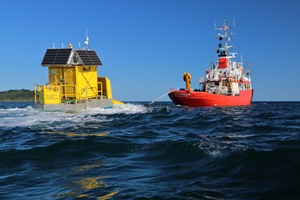
These datasets include data from CSP’s own deployments and a data-sharing arrangement with a commercial partner. Wood and CSP validated the input data against two mesoscale regional models, and further calibration produced this bankable wind resource model. The model now provides long-term mean wind speeds for the region.
The mean wind speeds for the two offshore CSP FLS locations indicate that the planned 4.932 GW of floating offshore wind (FLOW) deployment in the Celtic Sea by 2035 could produce enough electricity annually to meet the current needs of over 8 million UK homes.
Additionally, the FLS buoys were equipped with wave sensors to measure maximum wave heights at the two FLS locations. This new wave data, alongside the wind resource data, can support early design considerations for appropriate floating offshore wind structures in the Celtic Sea. It also provides early insights into potential future operations planning and ecosystem impacts.










